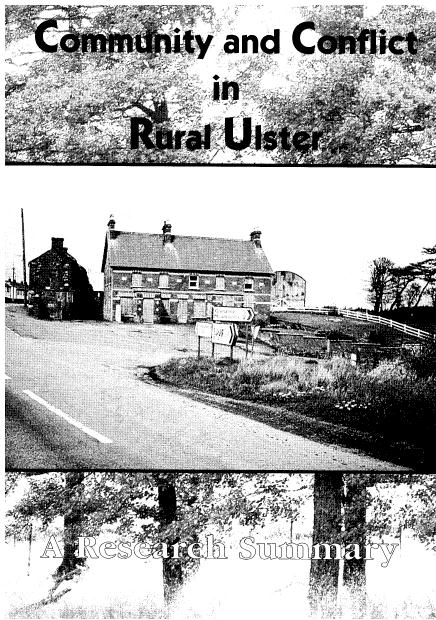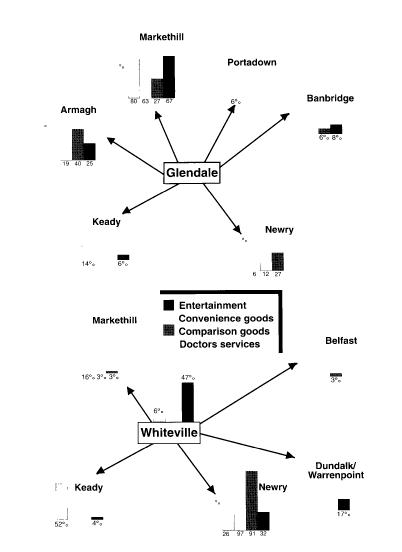|
Community and Conflict
in Rural Ulster

A SUMMARY REPORT
Dr. Brendan Murtagh
School of Social and Community Sciences
University of Ulster
1996
 
This Summary Report has been published by
the NI Community Relations Council
6 Murray Street
Belfast BT1 6DN
March 1997
The full research report will be published by
the University of Ulster
Contents
· INTRODUCTION
· POPULATION CHANGE AND COMMUNITY STABILITY
· LIFE IN A SMALL ULSTER TOWN
· LIFE ON THE RURAL INTERFACE
· LIFE AND THE LAND
· IMPLICATIONS OF THE RESEARCH
Introduction
This report summarises a programme of research into community
relations in mid-Armagh. The sorts of social processes that created
fourteen peacelines in Belfast do not stop at the green belt,
and this research aimed to see what effect, if any, they had on
rural communities with a tradition of high conflict. The research
used analysis of secondary data, household surveys and qualitative
interviews to build up a picture of life in the countryside.
Population Change and Community Stability
Since the early 1980s, some peripheral rural areas in Northern
Ireland have experienced population increase and South Armagh
has been no exception. This change has had an important impact
on the communities living in the middle part of the County. The
relaxation of planning controls explains much of, what has been,
a largely Catholic increase in population. As the Catholic population
has increased, the proportion of Protestants living near the border
has steadily declined. In the decade of the 1980s, the proportions
of Catholics living in Keady has increased by one-half a percent
a year whilst in Tandragee in the North of the County, the proportion
of Protestants increased by one- third of a percent a year. There
are also important differences between the population structure
in that, Catholics tend to have a younger age profile, higher
fertility rates, a larger than average family size and therefore
a greater opportunity for self-renewal. The relative increase
in the Catholic population to the South of the County and Protestant
population to the North has therefore had important effects in
the towns, villages and countryside in the middle of Armagh. It
is these consequences that this research is mainly concerned with.
Life in Small Town Ulster
The first part of the research examined the consequences of change,
community attitudes and prospects for the future in a small town
in the area with a survey of 202 households. The names of places
have been changed to allow respondents to speak freely and openly
about their true attitudes and so we refer to the to the study
area as Oldtown.
The town, located near the border with the Irish Republic, is
roughly two thirds Catholic and one-third Protestant. However,
Protestants were more likely to have lived in the village for
a longer period of time and were more likely to describe the village
as Protestant (76%). However, they were conscious that the area
was becoming more Catholic and 61% felt that the town would be
more Catholic in the future. Nearly one-half (47%) of Protestants
however wanted to retain a town mostly of their own religion and
this contrasted to one-quarter (25%) of Catholics who preferred
a Catholic town.
The research also showed that Protestants and Catholic had very
different experiences of the violence and potential agendas for
resolution of the conflict. For example, 29% of Catholics felt
that the town was more violent than other areas of Northern Ireland
compared to 53% of Protestants. Moreover, Protestants felt that
decommissioning paramilitary weapons (82%) was the key to progress
whilst Catholics prioritised more sensitive policing (76%).
Community attitudes in small town Ulster therefore needs to be
understood in the context of the experience of living through
violence, perceptions of ethnic sustainability and the extent
to which demographic change is not detrimental to the link between
community and place. In Oldtown, the recent history of Protestants
is an important backcloth for attitudes and behaviour:
"We saw our friends and relatives killed here and the
people who did it or set them up are still walking around free
... and can 't be touched. It s very hard to talk of community
relations when these people are given protection" Oldtown
resident.
Life on the Rural Interface
The focus of the research narrowed to consider life in two small
villages to the east of the study area.A total of 55 people were
interviewed in Whiteville" a predominately Catholic village
and Glendale", a mainly Protestant village. l)espite the
fact that the villages were one mile apart, there was relatively
little contact between them. Again the different histories of
the two communities have a telling impact on relations, contact
and perceptions of identity between them.
Ten workmen leaving the factory in Glendale where ambushed and
killed in 1976 and shortly afterwards the factory closed, the
local UDR base was destroyed by a massive bomb in 1983, the local
post office and primary school closed last year and the local
Orange Hall was burned in 1995. This catalogue direct and indirect
events has important implications for the local institutions upon
which any community needs to survive and sustain its population
As with Oldville, a high proportion of residents (50%) want to
see the Protestant identity of the village maintained and this
contrasts to Catholics living in Whiteville who were more likely
to have preferred an integrated population profile (62%).

The most enduring impact of community differences on behaviour
is in the way people interact through daily activities such as
shopping and going for services. The diagram below shows where
people from the villages go for shopping for every day (convenience
goods), for larger domestic products (comparison goods), GP services
and entertainment.This shows that people in Catholic Whiteville
travel mainly to Newry, the biggest town in the region, for most
of their shopping and service requirements. Indeed, there is some
evidence that people will travel across the border for entertainment
purposes. This contrasts strongly with the residents of Protestant
Glendale, who look to mainly Protestant towns to the North of
the region such as Markethill, Portadown and Armagh for the same
service.
Life and the Land
The final part of the research looked at life and the open land.
In particular, it emphasised the limited extent of land exchange
between members of the two religions. This is not a unique to
Armagh and studies in County Antrim showed that of the 529 exchanges
of property in Glenravel ward in the 29 years between 1958 and
1987 only 13% happened across the religious divide.1
Our research highlighted the way in which an institutional system
has built up to maintain these patterns. Therefore, there is often
separate auctioneers, solicitors and estate agents dealing with
Protestant and Catholic land exchange thus ensuring that there
is relatively little seepage' between these dual land markets.
This contrasts with the close working relationships between farmers
on a day to day basis. For instance, the tradition of sharing
labour and machinery at peak times of the agricultural year, the
normal exchange of livestock and produce at local 'marts' and
even letting land on long leases or 'conacre' are all well established
practices in the County. However, the transfer of land ownership
is neither widely practiced nor accepted within each religious
grouping.
Implications of the Research
The research has helped to highlight the extent to which religious
dlifferenccs are strongly acted out in rural areas with very different
perceptions of identity and experiences of the violence, territorial
behaviour and ownership of land all signaling the importance of
feelings of belong to particular areas and places.
Many of the problems confronting communities in rural areas result
from relative shifts of population combinedl with the hurt and
fear of violence. Community reconciliation has an important role
to play in identifying and describing the nature of problems in
these localities. In this way, there is a clear link between community
relations and community development as the former can only proceed
effectively if emotional andl practical security and long term
confidence can be secured for that community.
However, it is also about regenerating communities and this respect
government generally and rural development agencies in particular
have a central role to play. Targeting resources and programmes
at areas and issues that will enhance the community opportunities,
for those marginalised in the violence, is a major and often under-looked
task. Decisions taken for rational policy reasons can have disastrous
impacts on communities such as the closure of the primary school
in Glendale. These types of decisions must be taken within the
wider context of efforts to restore community confidence andl
stability in highly vulnerable areas The benefits to rural society,
the resolution of conflict and the quality of peoples lives can
not be undlerstated.2
1 Kirk,T. (1993) The Polarisation of Protestants and
Roman Catholics in Rural Northern Ireland: A Case Study of Glenravel
Ward, Unpublished Ph.D. Thesis, Queens tiniversity, Belfast.
2 This research was funded by the Central Community
Relations Unit with support from the European Regional Development
Fund. It was also part-funded by the Community Relations Council.
The funders and all those who contributed to the research are
gratefully acknowledged.
© CCRU 1998-1999
site developed by: Martin Melaugh
page last modified:
Back to the top of this page
|
|